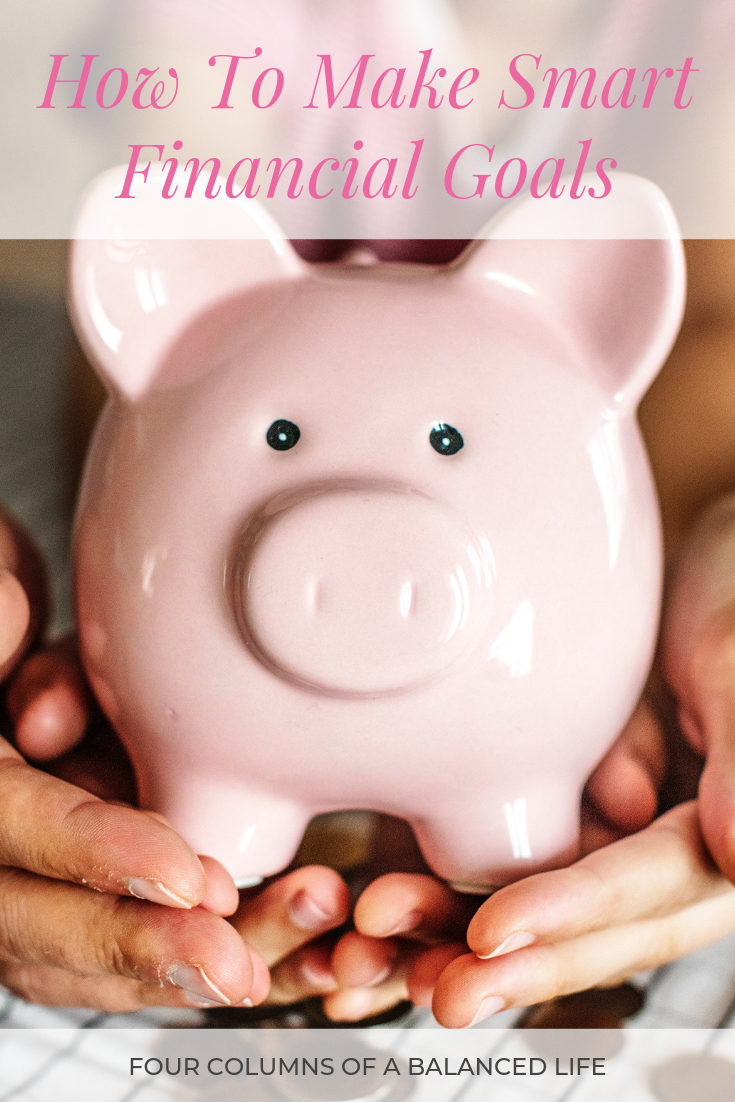How To Make Smart Financial Goals

How to make SMART financial goals. Welcome to my series, How To Use Money To Make You Happier.
In the introduction section, I gave some stats and mentioned a few reasons for starting this series.
I am going to break this series into a couple of steps:
- Introduction
- Make SMART financial goals
- Create a budget
- Income
- Expenses
- Needs and wants
- Debts
- Difference between good and bad debt
- Pay off debt
- Use credit to your advantage
- Give to charity
SMART Goals
It must be borne in mind that the tragedy of life doesn’t lie in not reaching your goal. The tragedy lies in having no goals to reach – Benjamin Mays

I am a big fan of having goals that are SMART. Your financial goals need to be specific, measurable, agreed upon, realistic, and time-based.
Your financial goals must be defined and clear to you. It should be obtainable and you need to know and find out when it has been achieved. It needs to be agreed either by you, by everyone in the family or household, within the time frame to achieve the goals.
Three Kinds of Financial Goals
I want you to take a piece of paper and a pen and write down your goals.
Divide your goals into three parts.
The short-term goals are those that you want to achieve between 1 and 3 years.
Car repairs, home repairs, home improvements, vacation, personal items, credit card payment, student loan payments, insurance, rent or mortgage payment, emergency fund, and any other day to day expenses come under short term goals.

Medium-term goals are those that you want to achieve between 4 and 10 years.
Saving for a down payment on a house, debt payments, saving to buy a car, are examples of medium-term goals.

Long terms goals are those that you want to achieve after 10 years from now.
Saving for retirement, paying off your mortgage, saving for your children’s education are examples of a long-term goal.
When you set goals, you are setting a foundation upon which to build your future.
The goal of this series is for you to use your money to make you happier. As a result, you need to focus on the fact that your goals are there, so you do not worry, have shelter, food, enjoy your hobbies, have a car, go on vacations and save for your children.

Specific
A specific goal needs to answer which, why, where, who and what you want to achieve.
The what goal could be to save, so you can tour Europe.
You might want to pay off your mortgage in the next fifteen years. A goal could also be that you want to retire by 55. Another example would be, you want to go to the gym four times a week.
The why goal is there for a reason. Why do you want to tour Europe? Do you want to see different countries? Do you want to experience different foods and cultures? Why do you want to pay off your mortgage in the next fifteen years?
The why has to be aligned with your goals, values, vision, and mission about your life. There needs to be a link here. Once that link is there, you will be happier.
The where goal looks at what gym you want to join to go four times a week?
The who looks at everyone else involved in your life. If you are single then that is good also. If you are married or living with someone, then the who looks at all the other people involved in your life who might be impacted by this goal.
The which factor looks at the exercises you will do to stay in shape. The other factor is which countries do you want to visit in Europe?

Measurable
The measurable aspect will look at how much. How much looks at the amount of money you have to save to go to Europe. How much do you need to save to retire at 55? How much is the mortgage and what will it take to get it accomplished? You need to measure; how much you are saving monthly or quarterly for that vacation.

Achievable
The financial goal needs to be achievable. As you get closer to your goal, you will feel good and motivated. Do not create some pie in the sky.

Realistic
Keep in mind all those around you. If you have a mortgage, two car payments, and a couple of kids, then making a goal to save $40,000 in a year is not a realistic goal.

Time-Based
Your goals need to be based on a time limit.
I want to show you, how you can do a SMART goal to pay off your mortgage or student loan in 20 years.
‘I want to pay off my student loan in 20 years’. ‘We want to pay off our mortgage in 20 years’. This is an example of a specific goal.
‘The balance of my student loan is $ 20,000, I want to bring it to zero by 2039’.
‘We want to pay off our mortgage of $250,000 by 2039 is another example of a measurable goal’.
If you are a single professional and making decent money, then maybe paying off $ 20,000 in student loans over a 20-year period is attainable. The same is possible for the mortgage.
In order for the goal to be realistic then your income and lifestyle need to match the goal.
The 20 years is the time-based goal.
Take some time and complete this assignment.
Thanks for reading and do write back to me as to how you are coming along with this and if you have any challenges.

Photo Credits: bongkarn thanyakij Andrea Piacquadio

Excellent article. I look forward to the other articles. The Millennials need this in our lives.
Very informative – thank you!
That’s some great advice here.
I think the biggest mistake that most people make with their finances is that they fail to set any tangible goals at all. They may say they ‘want to be a millionaire’ or ‘plan on retiring early’ but they never take it any further.
Britt | http://unapologeticallyyou.org
Great article narrated on practical basis. Thanks for sharing!!
Great points! Thanks for sharing
Love SMART goals- so important for actually having a plan to work toward. Great tips and advice here!
Fantastic tips. Smart goals are SO important!
Excellent advice here! SMART goals are one of the core tenets of a great financial plan – everyone should regularly revisit them too! Thanks for the tune-up!
I love SMART goals but i did not think of using them for a budget. I also like that you clarified “short” goals as 1-3 years. That is short when you think of paying debt and saving. Great breakdown!
This is written very well and clearly. Thanks. I look forward to reading the rest.
Your article is exactly what I needed today. We have a goal of paying off credit card debt in 5 years and I’d like to make it sooner. I’m going to use these methods to refine our plan.
Goals are huge, especially when it comes to finance! Having a long term goal that you chip away at is so much easier than having to pay for something big like a home repair when you haven’t been planning for it. Great post!
great read, especially setting time limits on your specific goals.
Applying the SMART method and dividing goals in three parts is a great approach! I think we fall into that “couple of kids” category multiplied by 3! Lol!
Love how you broke each category down . Thanks for these tips.
Great tips that I’ll be sure to implement myself. Thank you!
I am all about making smart goals. But we need to be mindful of how we set out to achieve the goals. Thanks for sharing great post!
Thanks. This was a useful read.
SMART goals takes the edge off setting unrealistic goals. You are so right, our lifestyle and income must match inorder for us to accomplish our goals. Great blog.
Loved the insightful things mentioned as well as the thoughts that are well researched one!! These are some really good goals to have in life if you want a good productive lifestyle. Thanks for sharing
This is really helpful. I need to plan for financial goals.
Great quote by Benjamin Mays! Wonderful post with a clear explanation on SMART goals. Failing to make a goal will guarantee you miss it every time. Making SMART goals will help you achieve your goals step by step.
If you are the type of person who doesn’t really know how to handle hard earned money or you are you having a financial problem then you definitely landed on the right page.